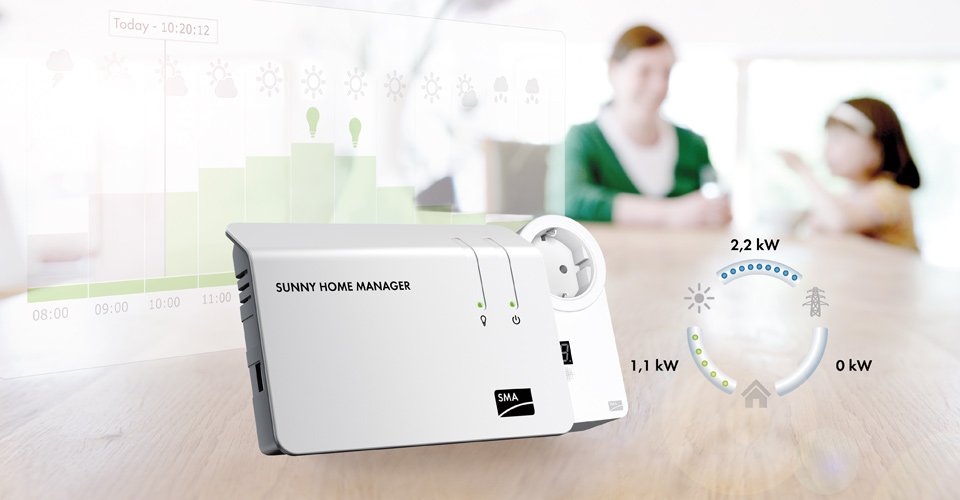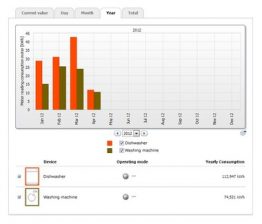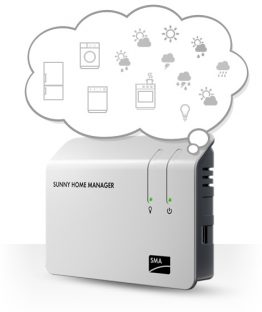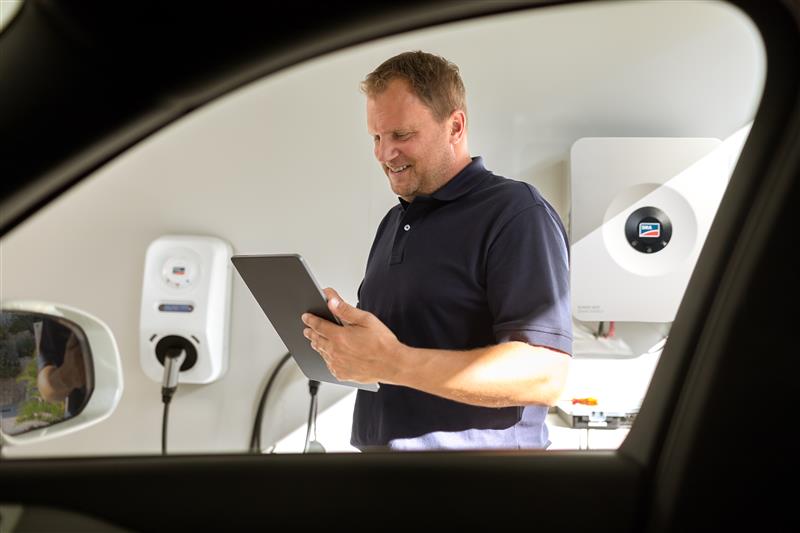Intelligent Energy Management with the Sunny Home Manager

Energy from conventional sources is becoming more and more expensive. As a result, people are increasingly interested in using energy when costs are low – for example when their PV system is producing abundant current. However, being able to use energy to get the most out of it also involves a number of other considerations. This article describes smart energy management with the Sunny Home Manager.
What exactly are energy management systems, and why are they useful?
Energy management systems work in several ways to optimize energy consumption. They help people use energy as efficiently as possible – thereby reducing their overall consumption. By intelligently controlling energy flows, they also reduce the load on the utility grid. The greatest advantage for users, however, is that they help lower their electric bill by timing energy use. Probably the simplest way to achieve optimal energy consumption is to pay attention to it, avoiding unnecessary use or to at least use energy when costs are low.
But that’s where the difficulty lies; many people rarely read their meter. An energy management system helps them use energy wisely by recording and displaying energy flows so they know how much electricity they use at any given time. They can also easily see when they typically use the most, or which appliances draw the highest load.
In addition to its monitoring and analysis functions, an energy management system can start appliances at just the right times to optimize consumption. There are two ways to do this. The simplest is to control the supply of electricity to the appliance (such as a heat pump) with an on/off switch. In the ideal situation, the energy management system can even communicate with each appliance – picture, for example, a washing machine with a USB connection.
Sunny Home Manager – for intelligent energy consumption
That’s exactly what the Sunny Home Manager does. Connected to as many as three energy meters, it always knows the energy demand and power generation capacity. It also knows the weather forecast for “its” PV system, so that it can estimate how much energy the system will generate in the hours ahead. In addition, it knows the time-of-use electricity rates. Taking this and other data into account, it can decide when it is more economical to use self-generated current and when it pays to feed it into the grid.
The Sunny Home Manager clearly displays all this information on the Sunny Portal status screen. With this free online service from SMA, users can view their PV current generation and household energy status anytime and from anywhere (Internet access required). Of course, the service works not only on a computer, but on smart phones and many other Internet-ready devices. With Sunny Portal, users can even turn household appliances and electrical devices on and off remotely. In addition to displaying household energy flows, Sunny Portal features a very simple visual prompt that indicates the best times to use additional energy – for example, operating an electric lawnmower or other high energy loads when excess energy is available.
The Sunny Home Manager can operate up to 10 SMA radio-controlled sockets, independently activating simple appliances such as a dishwasher or washing machine. This takes advantage of a feature often available in modern appliances: After a power outage, the program resumes exactly where its sequence was interrupted. The SMA radio-controlled socket simulates this “outage.” The Sunny Home Manager then ensures that power is restored and the appliance is turned back on when it makes the most sense.
This makes it possible to incorporate almost all standard appliances already in the household into the energy management system. Once activated, appliances are not interrupted; they continue operating normally, with no loss in performance quality because of the automatic control.
With premium appliances such as Miele clothes washers and dryers, which are “smart grid ready,” the Sunny Home Manager can “converse” via the network interface and start them even without an SMA radio-controlled socket.
By the way, SMA sockets are also an excellent way to hunt for hidden energy hogs. How many of us know how much current a phone charger, wireless router, or water heater consumes? An SMA radio-controlled socket, simply inserted between the load and the outlet, supplies detailed information about both how much energy the appliance uses, and when. Often, this makes it possible to detect major energy guzzlers that have gone unnoticed.
What exactly is intelligent about energy management with the Sunny Home Manager?
Unlike many other products on the market, the Sunny Home Manager is not just a threshold switch that activates a load as soon as a certain power level is available. Instead, the Sunny Home Manager calculates timetables so appliances are used at the perfect times. Calculations are based on future production, future loads, and the price of electricity in the hours ahead (even for complicated pricing models).
Using what it knows about the attached PV system and a weather forecast for its precise location, the Sunny Home Manager estimates the anticipated power generation capacity. For example, it recognizes and takes into account shade affecting the panels, even if this is not in the weather report.
The Home Manager also precisely monitors power consumption, tracking periods when loads are high or low. This enables the Home Manager to forecast typical situations and include them as it creates at timetable. For example, if mom typically cooks dinner later on Tuesdays because she has to pick up junior from sports practice, the Sunny Home Manager factors this in.
Now the Sunny Home Manager has nearly all the information it needs to generate a timetable. Take for example a washing machine with a hot water cycle that consumes 2.5 kWh of energy. Of course, the washing machine doesn’t use power uniformly throughout the cycle. The heating stage or spin cycle will demand more power than the simple agitation stage. The Sunny Home Manager also takes this into account. It can even schedule the heating stage of a normal laundry cycle to take place in the pause between the two rinse cycles of a dishwasher. Now that’s energy management.
Complex analysis functions also enable the Sunny Home Manager to deal with constantly changing power consumption. Sudden changes in weather and various household situations – vacation, a surprise party – are no problem for the Sunny Home Manager. For example, if someone fires up the electric grill to barbecue while a cake is baking in the oven, the Sunny Home Manager will make sure that the washer and dryer don’t run until the next time low-cost power is available.
Isn’t it a lot of work to shift loads around?
It does take a little adjusting to make the most of what the Sunny Home Manager can do. At night or in the morning, I load the dishwasher and washing machine and activate the automatic control for each with the click of a button. The Sunny Home Manager does the rest. When the washer is done, my wife moves the laundry to the dryer and activates its control. The whole thing is really simple, and it’s hardly any trouble once you’ve gotten used to pushing one more button after you turn on the appliances.
And here’s yet another useful feature: Our young daughter takes a nap at about the same time every day – and the Sunny Home Manager even considers this. I have programmed it not to run the washing machine during naptime, so the spin cycle doesn’t wake our little darling up
* In my household, I have tried to take full advantage of the Home Manager’s potential by using all 10 of the available SMA radio-controlled sockets. Because I have a battery storage system installed, it makes sense to manage even the smaller loads. Several days out of the year my house is almost completely self-sufficient.
Further interesting links:





I’m very interesting in the full offgrid solution of SMA with the Island converters (with speedwire). I plan to have a SB3000TL-21, a SB5000TL-21 and an Island converter with 30KWh storage. I would like to have the consumption controlled by a home manager and some smart devices like miele@home. I’ve tried to get some info from SMA support but I get different and contradicting info like that Home manager won’t work with Island converters in offgrid mode and that I should use a Webbox (which is already phased out). Or they have no info at all and tell me it’s better not to be offgrid (what was not my question).
I just like to have devices (washing machines, boilers, heatpump) switched on or off depending on battery state and PV-yield and an (interactive) visualization of the energy flows for the user to know if they can turn on the oven or that it’s better to cook on gas.
Is the home manager the right solution for Offgrid? Could someone advice me?
Best regards,
Boerkoel
Dear Mr. Boerkoel,
Thank you for your message.
It is possible to install a Sunny Island system in off-grid mode with speedwire communication interface and the Cluster Controller. The Sunny Home Manager is only for grid connected applications.
If you have a single Sunny Island you can use one relay to turn-on the generator and the another one to turn-on some “special loads” in case of high SOC. Unfortunately with this system is not possible to visualize the energy flows.
An external company, Elektro Meisl offers a device able to measure and manage the loads with our devices. Maybe they can offer you a monitoring solution.
Best regards,
Sarah
I am very much interested in a SMA FLEXIBLE STORAGE SYSTEM at my residence in Barbados. (Caribbean ) I currently have (2) two Sunny Boys 5000TL-21 & a Sunny Island 6.0 H installed at the residence connected to a sunny webbox w/ bluetooth. I have a SMA Sunny Home manager & a SMA speedwire module in my possession. To complete the above system I need a Energy meter that is compatible my environment which is a split phase 115V, 50 Hz. Can anyone recommend an Energy Meter that allows me to have a SMA FLEXIBLE STORAGE SYSTEM?
Can you tell me when the home manager would be able to control a grid tied SMA inverter, SMA Sunny Island and be able to deal with 0% export?
Hello Charlie,
Grid tied inverters are supported, also zero export of energy with the firmware version 1.11.4.R (January 2015).
For the Sunny Island the zero export is not yet supported. The release date for this function is not announced yet.
Please have a look at our documentation : http://www.sma.de/en/products/monitoring-control/sunny-home-manager.html
Best regards
Leonie
Hello
Thank you for your response.
I currently have a number of SMA grid tied running at 0% export, albeit via a third party PLC and meter. However I would very much like to be able to use the Sunnny Island as an extension to some of these systems. Is there any other way that export can be controlled with and SMA grid tied inverter and Sunny Island?
Regards
Hi Christian
I have a Sunnyboy 5000tl and a Sunny Island 6 installed.I also have batteries installed. My problem is that during the day when my pv production is high the Sunnyboy keeps switching off and the batteries kick in for a short period before the Sunnyboy starts up again. This leaves the batteries not fully charged at the end of the day and when the grid kicks in it has to charge the batteries.
Any advice please, is the system maybe not set up properly?
Thanks
Hi Andrew,
It seeems as you have an Off Grid system.
In this case the Sunny Island rises the frequency of the island grid when the battery voltages gets to the level of the battery charge voltage.
Such a high battery voltage appears when there is more energy in the system than the loads or the batteries need.
The frequency change tells the PV inverter to decrease their power input.
Normally the battery voltage gets lower after a short while, the Sunny Island can set the frequency back to 50Hz and the PV inverter can feed in again.
In order to let the Sunny Boy react the correct way its country setting has to be “Off Grid”.
Please check if this is shown in the display when you start the Sunny Boy.
If it is already set to “Off Grid” you may contact us via SunnyIsland.Service@SMA.de in order to discuss what can be done in order to avoid that the Sunny Island has to change the frequency.
Best regards
Leonie
Hi Christian
Am I correct in assuming that it will be possible to set the system to not feed back any electricity into the grid?
I’m from South Africa and we are battling to get the authorities to make it bearable to run grid tied systems. At this stage in Cape Town where I live you can feed into the grid but the fees you pay per month to have such a connection makes it a joke as the cost of having the point takes away most of the motivation for installing a PV system. The cost to have such a connection is already equal to half my annual electricity bill, and that’s before I used any electricity.
Thus my idea is to set up a system that will not feed back into the grid but are grid tied. In that case I will not have to register as a small scale generator, subsequently not pay the ridiculous fees and will use as much of the electricity the PV system generate myselfs to just lower my grid purchase as far as possible.
That together with some appliance management will for now be my aim.
Can you confirm that it will be possible with the SMA home manager system?
Hi Willem,
fortune is with you 🙂
Some days ago we released Home Manager Version 1.11.14.R which features Zero Export Control (0% Feed-in) for realisation of residential PV Systems with 100% self-consumption.
From the release notes: “According to measured PV generation and household consumption levels, SMA PV inverters are dynamically controlled to avoid any feed-in of PV power into the grid.
Complies with regional requirements by grid operators/power companies (i.e. in Australia/Spain/Chile)
This version does not yet support battery inverters (SunnyBoy Smart Energy/Sunny Island or other manufacturers).”
I will send you some details via email. Please let me know if your local grid utility accepts this function and relinquishes from those extra payments.
Sunny regards,
Christian
Hi Christian
Any system that has a zero export will be accepted. With our normal prepaid meter that’s installed in some houses you can basically do what you want after the meter as long as it’s inspected to be safe.
The thing with the prepaid meters is that it will decrement your credit for any current direction. So with such a meter it’s very much in you interes to have zero export otherwise you pay for your grid feed in. The reason is simple for the meters working like that, it’s simply so that if someone messes with the meter wires and turn them around that they can’t ”score”.
If you apply for a grid feed-in connection they replace your meter, analog or pre-paid, with a bi-direction 4 quadrant prepaid meter that can distinguish between current directions. Once your installation is inspected they will activate the feed in function of the meter to decrement at R1.00 per kwh and to increment at R0.50 per kwh for feed in. In addition you have to pay R13 per day to have this account plus you have to pay for the cost of the four quadrant meter. If you do the math you’ll see that for a household scale electricity usage it’s not worth it anymore to install this type of grid tied system. If you’re a bussiness with a much bigger use it can still be worth it.
Normal tariff without this account for a normal user is R1.50 per kwh.
The reason for this whole scheme is so that the municipality doesn’t lose money when every one goes solar… really short minded…
Off coarse if you have the old analog disk meters what a lot of people do is to just run their systems , because the meter will just reverse, and size it so that you will never feed back more that you pull from the grid in order that your meter reading will never be lower than the previous month, that way they can never pick it up and you effectively use the grid as a battery with a 100% efficiency.
So that and or setting up a system with zero grid feed in will be my two options.